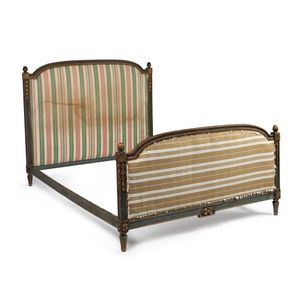Louis XVI Style Gilded Bed with Cream Striped Upholstery
A Louis XVI style carved, painted and gilded bed, 19th century, the lightly distressed frame with bead, paterae and pendant husk motifs, upholstered in cream, pink and green stripe fabric, the end board conforming, the headboard 128 cm high, 155 cm wide, 195 cm deep
You must be a subscriber, and be logged in to view price and dealer details.
Subscribe Now to view actual auction price for this item
When you subscribe, you have the option of setting the currency in which to display prices to $Au, $US, $NZ or Stg.
This item has been sold, and the description, image and price are for reference purposes only.
- Husk Motif - The husk motif is a decorative element that has been used in furniture, silver, glass and ceramics decoration for centuries. The motif is typically based on the shape of the husk, or outer covering, of a nut or seed. It is often depicted as a series of overlapping, scalloped shells that create a textured, ornamental pattern.
In furniture, the husk motif is commonly used in the design of chair and table legs, as well as in the decoration of cabinet doors and drawer fronts. The motif is carved into the wood or other material, creating a three-dimensional effect that adds depth and visual interest to the piece.
In ceramics, the husk motif is used in a variety of ways, from the decoration of bowls and plates to the design of decorative tiles and other objects. The motif is often painted or carved into the surface of the clay, creating a relief pattern that adds texture and dimensionality to the piece.
The husk motif has been used in many different historical and cultural contexts, from ancient Greece and Rome to 18th-century France and England. It has been adapted and modified over time, with variations including the acanthus leaf and the palmette motif. - Gilding - Gilding is a method of ornamentation whereby a thin sheet of gold metal is applied to items made of wood, leather, ceramics, glass and silver for decorative purposes.
For furniture including mirrors, the sheet of gold is usually applied over a coating of gesso. Gesso is a mixture of plaster of Paris and gypsum mixed with water and then applied to the carved wooden frames of mirrors and picture frames as a base for applying the gold leaf. After numerous coats of gesso have been applied, allowed to dry and then sanded a coat of "bole", a usually red coloured mixture of clay and glue is brushed on and allowed to dry, after which the gold leaf is applied. Over time parts of the gilding will rub off so the base colour can be seen. In water gilding, this was generally a blue colour, while in oil gilding, the under layer was often yellow. In Victorian times, gilders frequently used red as a pigment beneath the gold leaf.
Metal was often gilded by a process known as fire gilding. Gold mixed with mercury was applied and heated, causing the mercury to evaporate, the long-term effect of which was to kill or disable the craftsman or woman from mercury poisoning. The pursuit of beauty has claimed many victims, not the least of which were the artists who made those pieces so highly sought after today. - Patera - A small decorative device, used as ornament in Neo-classical style furniture. Patera (or paterae) are usually round or oval, in the form of stylized rosettes. In the best pieces they are carved directly into the timber, otherwise they applied to the surface. Sometimes painted or inlaid motifs in the style are referred to as patera. Also known as a boss or a rosette.
- Distressed - Usually applied to describe the condition of an item of furniture, and means that the object is extremely worn and is verging on being unsuitable for its intended use, without some restoration or repairs being undertaken.
Furniture can also be artificially distressed, by deliberate infliction of superficial damage to make it appear old. Artificial distressing can be done with the object of deceiving a purchaser, where the object is being passed off as "of the period", or can be done for aesthetic reasons so that a new object is made to appear as though it has been in use.
This item has been included into following indexes:
